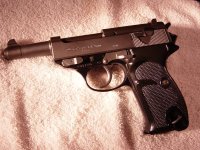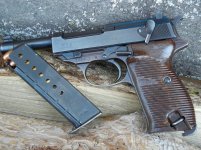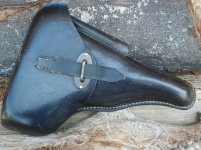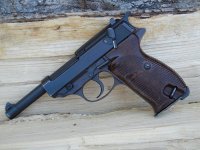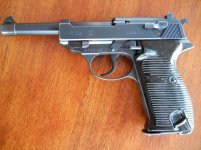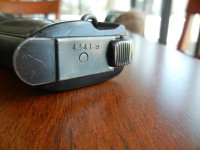Nice one.
The Post War guns were plentiful and relatively inexpensive for a while,but the supply is gone or nearly so.
Prices are going up on the run of the mill variety. There are some collectibles already ID'd in the Post War production that get special $$ if the seller knows what they have.
I have a P1 Model, nothing special. The plain non-reinforced frame,standard slide model. Shoots very nicely and is one of the few semi-autos I still shoot as the slide is very easy to operate.
I just shoot Rem-UMC type FMJ or my standard load cast bullet handloads through it. Feeds & ejects w/o problems. I don't ask it to do anymore than that.
Check the recoil spring guides on the post-war pistols as they are made of plastic/nylon type material.
The small guides are at the front of each of the dual recoil springs on the frame. They stay in place when the gun is field stripped and in fact are what holds each recoil sping in place on the frame while the slide is off.
The small enlarged head/engagement area of the guide can wear allowing it to jump unexpectedly out of it's captive machined cut in the frame when the slide is taken off of the pistol in TD.
You could still buy many unused original parts for the P1/P38 Post-War guns including the guides very recently. I don't know if that's changed.
Replacing the recoil springs is another often mentioned must thing to do.
Check them out,,they're not all worn out. Replace as necessary. Standard # is all that's needed.
Post war guns made changes in the slide starting in about 1967,,or ser# 312,000.
The problem was cracking of the slides was showing up. (Similar cracking shows up on War time mfg P38s)
The slide dimensions were beefed up. The term 'fat slide' model is given to those pistols equipted with them.
One way to ID them is that the slide serations go all the way to the front of the safety lever on the fat slide type.
The Post War alloy frames were also fitted with a hex pin inserted through the frame just above the trigger.
Inside where the locking block contacts the frame, the large steel pin would now take and transfer the energy to the alloy frame. Makes sense for longer frame life. Other pistols do that. The HK4 has a steel insert moulded into the alloy frame at the abutment point inside where the slide hits.
This was started around ser# 370,000.
This is past where the 'fat slide' was introduced.
From what I can gather,,new production pistols from that # and on were factory made w/the hex pin. I'm told older pistols were not refitted with the pin, but rather rebuilt and refitted w/an entirely new frame (that included the hex pin) when and if they came into the factory for upgrade.
Some will disagree with that, I don't get into the details of the collector aspect anymore because of headaches that follow,,,so I leave it at that.
Safe to say most any combination of an unpinned or pinned frame, and a standard or 'fat' slide is likely to show up on an earlier post war production.
They all seem to work just fine.
Post war magazines are interchangeable with war-time mags. Post war mags have grooved followers, war-time does not. One way to tell besides the obvious markings or lack of them.
Lots of refinished post-war mags around, or at least there was!
The bbl is a 2 piece assembly on the P1/P38 post war gun. Pre-war guns are one piece. A point that gets argued about , which is better, which is not, why, ect. Personally I've never seen a post-war bbl fail because it was a 2 piece assembly. It just doesn't bother me.
I've retired my War-Time P38's from the range as there have been just too many that have cracked slides in normal use (see above).
It's just too difficult to replace a major part like a slide on one of these and they are getting/are too collectible now. They're not the $50 & $75 gun they used to be.
The Post-War P1/P38 fills in just fine.
Had mine out this afternoon...









